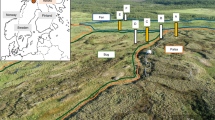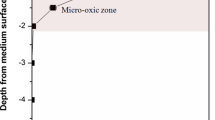Abstract
An agreement between the content of amorphous (oxalate-extractable) iron and morphochromatic features of gley attests to the modern activity of gleyzation processes in tundra soils of the Kolyma Lowland, especially within lower parts of gentle and steep slopes. A suprapermafrost reduced gley horizon thawing out in the warmest years is considered a relic of the warmer and wetter stage of soil formation. An integrated analysis of data on the contents of mobile iron and annotated metagenomes indicates that microorganisms affiliated with the Proteobacteria phylum capable of iron reduction predominate in sediments formed under hydromorphic conditions and in modern mineral soil. In laboratory experiments, the process of microbial iron reduction was more active at 5°C than at 20°C. Therefore, it can be assumed that the majority of cultivated communities of iron-reducing bacteria have been adapted to low Arctic temperatures. Under conditions of climate warming and an increase in precipitation, permafrost temperature, and thickness of the seasonally thawed layer, iron reduction processes in the soils rich in the total iron will play an even greater role and create favorable redox conditions for the formation of methane, one of the most important greenhouse gases.





Similar content being viewed by others
REFERENCES
E. V. Arinushkina, Manual for the Chemical Analyses of Soils (Moscow State Univ., Moscow, 1970) [in Russian].
S. V. Gubin and A. V. Lupachev, “Suprapermafrost horizons of the accumulation of raw organic matter in tundra cryozems of Northern Yakutia,” Eurasian Soil Sci. 51, 772–781 (2018).
Z. V. Zonn, Iron in Soils: Genetic and Geographical Aspects (Nauka, Moscow, 1982) [in Russian].
A. V. Lupachev and S. V. Gubin, “Suprapermafrost organic–accumulative horizons in the tundra cryozems of Northern Yakutia,” Eurasian Soil Sci. 45, 45–55 (2012).
E. P. Mulikovskaya, A. A. Reznikov, and I. Yu. Sokolov, Analysis of Natural Waters (Nedra, Moscow, 1970) [in Russian].
E. M. Rivkina, G. N. Kraev, K. V. Krivushin, K. S. Laurinavizhyus, D. G. Fedorov-Davydov, A. L. Kholodov, V. A. Shcherbakova, and D. A. Gilichinskii, “Methane in permafrost of the northeastern sector of Arctic,” Kriosfera Zemli 10 (3), 23–41 (2006).
D. G. Fedorov-Davydov, S. V. Gubin, and O. V. Makeev, “The content of mobile iron and gleyzation process in soils of the Kolyma Lowland,” Eurasian Soil Sci. 37, 131–142 (2004).
D. G. Fedorov-Davydov, N. S. Mergelov, and M. M. Morozov, “Soil cover of the Kolyma Lowland coastal yedomas,” in Proceedings of the International Conference “Cryogenic Resources of Polar Regions,” Salekhard, June, 2007 (Salekhard, 2007), Vol. 2, pp. 113–116.
D. G. Fedorov-Davydov, S. P. Davydov, A. I. Davydova, V. E. Ostroumov, A. L. Kholodov, V. A. Sorokovikov, and D. G. Shmelev, “Temperature regime of soils of Northern Yakutia,” Kriosfera Zemli 22 (4), 15–24 (2018).
A. Abramov, S. Davydov, A. Ivashchenko, D. Karelin, A. Kholodov, G. Kraev, A. Lupachev, et al., “Two decades of active layer thickness monitoring in northeastern Asia,” Polar Geogr., 1–17 (2019). https://doi.org/10.1080/1088937X.2019.1648581
J. P. Bowman, S. A. McCammon, D. S. Nichols, J. H. Skerratt, S. M. Rea, P. D. Nichols, and T. A. McMeekin, “Shewanella gelidimarina sp. nov., Shewanella frigidimarina sp. nov., novel Antarctic species with the ability to produce eicosapentaenoic acid (20: 5ω3) and grow anaerobically by dissimilatory Fe (III) reduction,” Int. J. Syst. Evol. Microbiol. 47 (4), 1040–1047 (2005).
D. Canfield, E. Kristensen, and B. Thamdrup, Aquatic Geomicrobiology (Elsevier, Amsterdam, 2005), Vol. 48. ISBN 9780080575407
R. E. Cowart, “Reduction of iron by extracellular iron reductases: implications for microbial iron acquisition,” Arch. Biochem. Biophys. 2, 273–281 (2002). https://doi.org/10.1016/S0003-9861(02)00012-7
D. G. Fyodorov-Davydov, A. L. Kholodov, V. E. Ostroumov, G. N. Kraev, V. A. Sorokovikov, S. P. Davydov, and A. A. Merekalova, “Seasonal thaw of soils in the North Yakutian ecosystems,” in Proceedings of the Ninth International Conference on Permafrost, University of Alaska, Fairbanks, June 29–July 3, 2008 (Fairbanks, 2008), Vol. 1, pp. 481–486.
S. Hedrich, M. Schlömann, and D. B. Johnson, “The iron-oxidizing proteobacteria,” Microbiology 157 (6), 1551–1564 (2011). https://doi.org/10.1099/mic.0.045344-0
F. Meyer, D. Paarmann, M. D’Souza, R. Olson, E. M. Glass, M. Kubal, T. Paczian, A. Rodriguez, R. Stevens, A. Wilke, and J. Wilkening, “The metagenomics RAST server–a public resource for the automatic phylogenetic and functional analysis of metagenomes,” BMC Bioinf. 9, 386 (2008). https://bmcbioinformatics.biomedcentral.com/articles/10.1186/1471–2105–9–386
S. L. Nixon, J. P. Telling, J. L. Wadham, and C. S. Cockel, “Viable cold-tolerant iron-reducing microorganisms in geographically diverse subglacial environments,” Biogeosciences 14 (6), 1445–1455 (2017). https://doi.org/10.5194/bg-14-1445-2017
S. A. Pecheritsyn, E. M. Rivkina, V. N. Akimov, and V. A. Shcherbakova, “Desulfovibrio arcticus sp. nov., a psychrotolerant sulphate-reducing bacterium from a cryopeg,” Int. J. Syst. Evol. Microbiol. 62 (1), 33–37 (2012). https://doi.org/10.1099/ijs.0.021451-0
E. Rivkina, D. Gilichinsky, S. Wagener, J. Tiedje, and J. McGrath, “Biogeochemical activity of anaerobic microorganisms from buried permafrost sediments,” Geomicrobiol. J. 15 (3), 187–193 (1998). https://doi.org/10.1080/01490459809378075
E. Rivkina, L. Petrovskaya, T. Vishnivetskaya, K. Krivushin, L. Shmakova, M. Tutukina, A. Meyers, and F. Kondrashov, “Metagenomic analyses of the late Pleistocene permafrost-additional tools for reconstruction of environmental conditions,” Biogeosciences 13 (7), 2207–2219 (2016). https://doi.org/10.5194/bg-13-2207-2016
Y. Ryzhmanova, T. Abashina, D. Petrova, and V. Shcherbakova, “Desulfovibrio gilichinskyi sp. nov., a cold-adapted sulfate-reducing bacterium from a Yamal Peninsula cryopeg,” Int. J. Syst. Evol. Microbiol. 69 (4), 1081–1086 (2019). https://doi.org/10.1099/ijsem.0.003272
T. Shi, R. H. Reeves, D. A. Gilichinsky, and E. I. Friedmann, “Characterization of viable bacteria from Siberian permafrost by 16S rDNA sequencing,” Microb. Ecol. 33 (3), 169–179 (1997).
A. I. Slobodkin and J. Wiegel, “Fe (III) as an electron acceptor for H2 oxidation in thermophilic anaerobic enrichment cultures from geothermal areas,” Extremophiles 1 (2), 106–109 (1997).
V. Vandieken, M. Mussmann, H. Niemann, and B. B. Jørgensen, “Desulfuromonas svalbardensis sp. nov., Desulfuromusa ferrireducens sp. nov., psychrophilic, Fe (III)–reducing bacteria isolated from Arctic sediments, Svalbard,” Int. J. Syst. Evol. Microbiol. 56 (5), 1133–1139 (2006). https://doi.org/10.1099/ijs.0.63639-0
B. A. Ventura, F. González, A. Ballester, M. L. Blázquez, and J. A. Muñoz, “Bioreduction of iron compounds by Aeromonas hydrophila,” Int. Biodeter. Biodegrad. 103, 69–76 (2015). https://doi.org/10.1016/j.ibiod.2015.03.034
E. Viollier, P. W. Inglett, K. Hunter, A. N. Roychoudhury, and P. van Cappellen, “The ferrozine method revisited: Fe(II)/Fe(III) determination in natural waters,” Appl. Geochem. 15 (6), 785–790 (2000). https://doi.org/10.1016/S0883-2927(99)00097-9
K. A. Weber, L. A. Achenbach, and J. D. Coates, “Microorganisms pumping iron: anaerobic microbial iron oxidation and reduction,” Nat. Rev. Microbiol. 4 (10), 752–764 (2006). https://doi.org/10.1038/nrmicro1490
E. A. Wolin, M. Wolin, and R. S. Wolfe, “Formation of methane by bacterial extracts,” J. Biol. Chem. 238 (8), 2882–2886 (1963).
C. Zhang, R. D. Stapleton, J. Zhou, A. V. Palumbo, and T. J. Phelps, “Iron reduction by psychrotrophic enrichment cultures,” FEMS Microbiol. Ecol. 30 (4), 367–371 (1999). https://doi.org/10.1111/j.1574-6941.1999.tb00664.x
ACKNOWLEDGMENTS
We are grateful to A.V. Lupachev for assistance in carrying out field researches.
Funding
This study was performed within the framework of state assignment no. AAAA-A18-118013190181-6 and was supported by the Russian Foundation for Basic Research (project nos. 19-29-05003-mk and 19-04-00831) and, partly, by the National Science Foundation (grant NSF DEB-1442262).
Author information
Authors and Affiliations
Corresponding author
Ethics declarations
The authors declare that they have no conflict of interest.
Additional information
Translated by T. Chicheva
Rights and permissions
About this article
Cite this article
Rivkina, E.M., Fedorov-Davydov, D.G., Zakharyuk, A.G. et al. Free Iron and Iron-Reducing Microorganisms in Permafrost and Permafrost-Affected Soils of Northeastern Siberia. Eurasian Soil Sc. 53, 1455–1468 (2020). https://doi.org/10.1134/S1064229320100166
Received:
Revised:
Accepted:
Published:
Issue Date:
DOI: https://doi.org/10.1134/S1064229320100166




